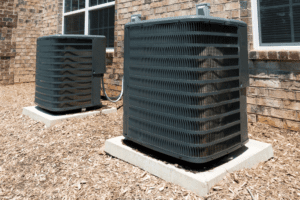California summers get hot, which means that commercial AC is an essential component of any business or office building. Driven by robust and powerful air conditioning units—often mounted on the roof of the building in question—commercial cooling systems use ducts to circulate cool air throughout the entire building. They keep the interior temperature reasonable and help to minimize humidity levels, thus creating a comfortable indoor environment that employees and customers alike can appreciate. But how do these big air conditioning systems work? How do they reliably manage the temperature for a large, sprawling commercial building? This blog post will examine the mechanics behind commercial air conditioning and the systems that drive it.
The Steps of the Commercial AC Process
 A central cooling unit for a commercial building is not wholly different from a central cooling unit in a home. Obviously, the size and scale are different. However, the process at work—which involves thermostats, return air, and refrigerant—is the same. Here are the basic steps that must occur for a central air conditioning system to cool a commercial building:
A central cooling unit for a commercial building is not wholly different from a central cooling unit in a home. Obviously, the size and scale are different. However, the process at work—which involves thermostats, return air, and refrigerant—is the same. Here are the basic steps that must occur for a central air conditioning system to cool a commercial building:
- A thermostat signals for air: When a thermostat in your commercial building detects that the air temperature in that space has risen above the set temperature, the thermostat will signal to the air conditioner that the system needs to activate to lower the temperature. Most commercial buildings are set up in different cooling “zones,” which means one zone can call for cooling without affecting zones in other parts of the building.
- The air handlers activate: When you hear the air conditioning kick on in your building, what you are hearing, initially, is the activation of air handlers. These air handlers draw warm air in from various parts of the building and through return vents and ducts, back to the air conditioning system. Along the way, the air passes through a filter (or multiple filters), which removes dirt, dust, and other particles. These filters are essential to prevent dust and dirt from recirculating through your building.
- The air conditioning system cools the refrigerant: The actual air conditioning unit (or units) on your building include three core components: the condenser, the evaporator, and the compressor. When the system activates, it circulates refrigerant throughout the system. When the system activates, refrigerant flows to the compressor, starting out as a gas. The compressor pressurizes the refrigerant, turning it from a gas in a low-pressure, extremely cold liquid. This cold liquid refrigerant then flows out of the compressor and into a coil of tubing the flows between the evaporator and the condenser.
- The coil cools the return air: The coil, now cooled by the liquid refrigerant, is situated in such a way that it receives the blast of air coming from the air handlers and the return ducts. The air, as it arrives, is warm, carrying the excess heat from the part of the building that is calling for a lower temperature. The refrigerant absorbs the heat in the air, rendering the air ice cold. The evaporator fan then blows the cool air back into the building’s ducts, to be recirculated and to lower the temperature back to the thermostat setting.
- The process restarts: When the cold refrigerant absorbs the heat from the return air, it gradually heats up itself, eventually turning from liquid back into gas. This gas flows back into the compressor, which pressurizes the refrigerant once more, turning it back into a low-pressure liquid. At the same time, any excess heat from the air is stripped from the refrigerant and jettisoned from the building as exhaust. Finally, the newly re-cooled refrigerant flows back into the rest of the system, to continue cooling the return air. This process repeats until the building (or building zone) is back to its thermostat setting. At that point, the entire system—including the air handlers and the air conditioning unit itself—shuts down until another thermostat calls for cool air.
As you can see, a central commercial AC system essentially gives the air its own “circle of life” within your building. Coming out of the AC unit, the air should be cold as ice. It goes through the ducts in your building and recirculates to the proper zone via supply vents. Over time, the air grows progressively warmer—whether because of body temperature, sunlight, open doors or windows, or some mix of all the above. Eventually, the air conditioner activates again, pulling that warm air in through return vents, directing it back to the air conditioner, and cooling it once more.
If something goes wrong with this process—or with just one part of your air conditioning system—it can impact the entire building’s ability to regulate temperature. If you notice that the air temperature feels warmer or more humid than usual—or if your air conditioning system seems to be switching on and off more than normal—there might be something wrong. Calling your preferred commercial AC technician for an inspection and repair should get your system back on track.

